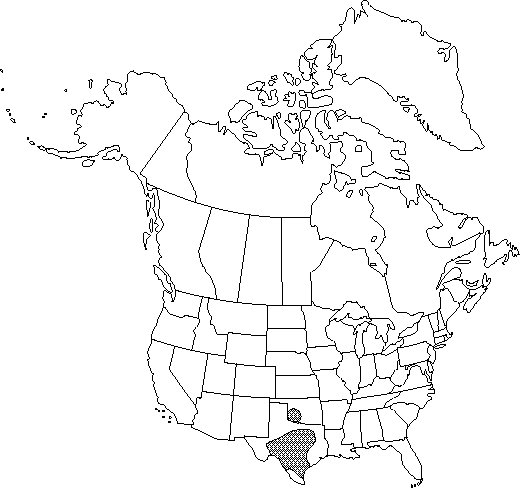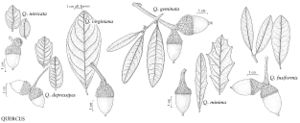Difference between revisions of "Quercus fusiformis"
Bull. Torrey Bot. Club 28: 357. 1901.
FNA>Volume Importer |
FNA>Volume Importer |
||
| Line 27: | Line 27: | ||
}}<!-- | }}<!-- | ||
| − | --><span class="statement" id="st- | + | --><span class="statement" id="st-undefined" data-properties=""><b>Trees,</b> sometimes shrubs, subevergreen, trees to 25 m, shrubs often forming large clonal stands. <b>Bark</b> dark brown or black, scaly. <b>Twigs</b> light gray, 1.5-3 mm diam., tomentulose, tomentulum often persistent in age. <b>Buds</b> reddish or dark brown, subglobose or ovate, 1.5-3 mm; scale margins glabrous or puberulent. <b>Leaves</b>: petiole 2-8(-12) mm. <b>Leaf</b> blade oblong-elliptic to narrowly ovate or lanceolate, sometimes obovate, ± planar, (10-)35-90(-150) × (15-)20-40(-85) mm, base rounded to truncate or cordate, rarely cuneate, margins minutely revolute or flat, entire or irregularly 1-3 toothed on each side, teeth mucronate (rarely spinose in suckers or juveniles), secondary veins obscure, 8-10 on each side, apex obtuse-rounded or acute; surfaces abaxially whitish or glaucous, densely covered with minute, appressed, fused-stellate hairs, light green and glabrate in shade leaves, adaxially dark or light green, glossy, glabrous or with minute, scattered, stellate hairs. <b>Acorns</b> 1-3, on peduncle 3-30 mm; cup funnel-shaped, hemispheric, or deeply goblet-shaped, 8-15 mm deep × 6-12(-15) mm wide, base often constricted, scales whitish or grayish, thickened basally, keeled, acute-attenuate, tomentulose, tips reddish, glabrous or puberulent; nut dark brown, often with light brown longitudinal stripes, subfusiform and acute to narrowly barrel-shaped, rarely distally rounded, (17-)20-30(-33) × 8-15 mm, glabrous. <b>Cotyledons</b> connate.</span><!-- |
-->{{Treatment/Body | -->{{Treatment/Body | ||
| Line 33: | Line 33: | ||
|habitat=Hills, grasslands, scrublands, open woodlands, oak-juniper woodland, and margins of thorn scrub, often on limestone or deep calcareous loams, sometimes on granular sand or gravel | |habitat=Hills, grasslands, scrublands, open woodlands, oak-juniper woodland, and margins of thorn scrub, often on limestone or deep calcareous loams, sometimes on granular sand or gravel | ||
|elevation=0-1200 m | |elevation=0-1200 m | ||
| − | |distribution=Okla.;Tex.;Mexico (Coahuila | + | |distribution=Okla.;Tex.;Mexico (Coahuila;Nuevo León;and Tamaulipas). |
|discussion=<p>The difficulty in distinguishing Texas populations of Quercus fusiformis from Q. virginiana is reflected in a variety of taxonomic treatments, including reducing Q. fusiformis to varietal rank under Q. virginiana. The latter disposition is problematic, however, because Q. fusiformis in northeastern Mexico is amply distinct from Q. virginiana and appears to be more closely related to Q. brandegei Goldmann, an endemic of Baja California, Mexico. Thus, here we assume that the intergradation of Q. virginiana and Q. fusiformis is a result of secondary contact, and is not primary clinal variation. Under this interpretation, Q. virginiana in typical form extends into Texas only as far west as the Brazos River drainage along the coast from there to the escarpment of the Edwards Plateau; most populations elsewhere are either intermediate between the two species or show greater affinity with Q. fusiformis. On the Edwards Plateau, the live oak populations are small trees forming rhizomatous copses (shinneries) and having mostly acute acorns.</p><!-- | |discussion=<p>The difficulty in distinguishing Texas populations of Quercus fusiformis from Q. virginiana is reflected in a variety of taxonomic treatments, including reducing Q. fusiformis to varietal rank under Q. virginiana. The latter disposition is problematic, however, because Q. fusiformis in northeastern Mexico is amply distinct from Q. virginiana and appears to be more closely related to Q. brandegei Goldmann, an endemic of Baja California, Mexico. Thus, here we assume that the intergradation of Q. virginiana and Q. fusiformis is a result of secondary contact, and is not primary clinal variation. Under this interpretation, Q. virginiana in typical form extends into Texas only as far west as the Brazos River drainage along the coast from there to the escarpment of the Edwards Plateau; most populations elsewhere are either intermediate between the two species or show greater affinity with Q. fusiformis. On the Edwards Plateau, the live oak populations are small trees forming rhizomatous copses (shinneries) and having mostly acute acorns.</p><!-- | ||
--><p>Populations of live oak on deep sands in south Texas differ from typical Quercus fusiformis in having broader, more rounded leaves, often with the secondary veins somewhat impressed abaxially, and relatively blunt, barrel-shaped acorns. These characteristics suggest introgresion from the Mexican-Central American species Q. oleoides Schlechtendal & Chamisso, which in its typical form reaches north only as far as southern Tamaulipas, Mexico. The name Q. oleoides var. quaterna C. H. Muller has been applied to what is apparently a shrub form of one of these Q. fusiformis × Q. oleoides hybrids.</p> | --><p>Populations of live oak on deep sands in south Texas differ from typical Quercus fusiformis in having broader, more rounded leaves, often with the secondary veins somewhat impressed abaxially, and relatively blunt, barrel-shaped acorns. These characteristics suggest introgresion from the Mexican-Central American species Q. oleoides Schlechtendal & Chamisso, which in its typical form reaches north only as far as southern Tamaulipas, Mexico. The name Q. oleoides var. quaterna C. H. Muller has been applied to what is apparently a shrub form of one of these Q. fusiformis × Q. oleoides hybrids.</p> | ||
| Line 54: | Line 54: | ||
|habitat=Hills, grasslands, scrublands, open woodlands, oak-juniper woodland, and margins of thorn scrub, often on limestone or deep calcareous loams, sometimes on granular sand or gravel | |habitat=Hills, grasslands, scrublands, open woodlands, oak-juniper woodland, and margins of thorn scrub, often on limestone or deep calcareous loams, sometimes on granular sand or gravel | ||
|elevation=0-1200 m | |elevation=0-1200 m | ||
| − | |distribution=Okla.;Tex.;Mexico (Coahuila | + | |distribution=Okla.;Tex.;Mexico (Coahuila;Nuevo León;and Tamaulipas). |
|reference=None | |reference=None | ||
|publication title=Bull. Torrey Bot. Club | |publication title=Bull. Torrey Bot. Club | ||
|publication year=1901 | |publication year=1901 | ||
|special status=Selected by author to be illustrated;Weedy | |special status=Selected by author to be illustrated;Weedy | ||
| − | |source xml=https://jpend@bitbucket.org/aafc-mbb/fna- | + | |source xml=https://jpend@bitbucket.org/aafc-mbb/fna-data-curation.git/src/9216fc802291cd3df363fd52122300479582ede7/coarse_grained_fna_xml/V3/V3_200.xml |
|genus=Quercus | |genus=Quercus | ||
|section=Quercus sect. Quercus | |section=Quercus sect. Quercus | ||
|species=Quercus fusiformis | |species=Quercus fusiformis | ||
| − | |||
| − | |||
| − | |||
| − | |||
| − | |||
| − | |||
| − | |||
| − | |||
| − | |||
| − | |||
| − | |||
| − | |||
| − | |||
| − | |||
| − | |||
| − | |||
| − | |||
| − | |||
| − | |||
| − | |||
| − | |||
| − | |||
| − | |||
| − | |||
| − | |||
| − | |||
| − | |||
| − | |||
| − | |||
| − | |||
| − | |||
| − | |||
| − | |||
| − | |||
| − | |||
| − | |||
| − | |||
| − | |||
| − | |||
| − | |||
| − | |||
| − | |||
| − | |||
| − | |||
| − | |||
| − | |||
| − | |||
| − | |||
}}<!-- | }}<!-- | ||
-->[[Category:Treatment]][[Category:Quercus sect. Quercus]] | -->[[Category:Treatment]][[Category:Quercus sect. Quercus]] | ||
Revision as of 13:35, 27 July 2019
Trees, sometimes shrubs, subevergreen, trees to 25 m, shrubs often forming large clonal stands. Bark dark brown or black, scaly. Twigs light gray, 1.5-3 mm diam., tomentulose, tomentulum often persistent in age. Buds reddish or dark brown, subglobose or ovate, 1.5-3 mm; scale margins glabrous or puberulent. Leaves: petiole 2-8(-12) mm. Leaf blade oblong-elliptic to narrowly ovate or lanceolate, sometimes obovate, ± planar, (10-)35-90(-150) × (15-)20-40(-85) mm, base rounded to truncate or cordate, rarely cuneate, margins minutely revolute or flat, entire or irregularly 1-3 toothed on each side, teeth mucronate (rarely spinose in suckers or juveniles), secondary veins obscure, 8-10 on each side, apex obtuse-rounded or acute; surfaces abaxially whitish or glaucous, densely covered with minute, appressed, fused-stellate hairs, light green and glabrate in shade leaves, adaxially dark or light green, glossy, glabrous or with minute, scattered, stellate hairs. Acorns 1-3, on peduncle 3-30 mm; cup funnel-shaped, hemispheric, or deeply goblet-shaped, 8-15 mm deep × 6-12(-15) mm wide, base often constricted, scales whitish or grayish, thickened basally, keeled, acute-attenuate, tomentulose, tips reddish, glabrous or puberulent; nut dark brown, often with light brown longitudinal stripes, subfusiform and acute to narrowly barrel-shaped, rarely distally rounded, (17-)20-30(-33) × 8-15 mm, glabrous. Cotyledons connate.
Phenology: Flowering spring.
Habitat: Hills, grasslands, scrublands, open woodlands, oak-juniper woodland, and margins of thorn scrub, often on limestone or deep calcareous loams, sometimes on granular sand or gravel
Elevation: 0-1200 m
Distribution

Okla., Tex., Mexico (Coahuila, Nuevo León, and Tamaulipas).
Discussion
The difficulty in distinguishing Texas populations of Quercus fusiformis from Q. virginiana is reflected in a variety of taxonomic treatments, including reducing Q. fusiformis to varietal rank under Q. virginiana. The latter disposition is problematic, however, because Q. fusiformis in northeastern Mexico is amply distinct from Q. virginiana and appears to be more closely related to Q. brandegei Goldmann, an endemic of Baja California, Mexico. Thus, here we assume that the intergradation of Q. virginiana and Q. fusiformis is a result of secondary contact, and is not primary clinal variation. Under this interpretation, Q. virginiana in typical form extends into Texas only as far west as the Brazos River drainage along the coast from there to the escarpment of the Edwards Plateau; most populations elsewhere are either intermediate between the two species or show greater affinity with Q. fusiformis. On the Edwards Plateau, the live oak populations are small trees forming rhizomatous copses (shinneries) and having mostly acute acorns.
Populations of live oak on deep sands in south Texas differ from typical Quercus fusiformis in having broader, more rounded leaves, often with the secondary veins somewhat impressed abaxially, and relatively blunt, barrel-shaped acorns. These characteristics suggest introgresion from the Mexican-Central American species Q. oleoides Schlechtendal & Chamisso, which in its typical form reaches north only as far as southern Tamaulipas, Mexico. The name Q. oleoides var. quaterna C. H. Muller has been applied to what is apparently a shrub form of one of these Q. fusiformis × Q. oleoides hybrids.
Selected References
None.
